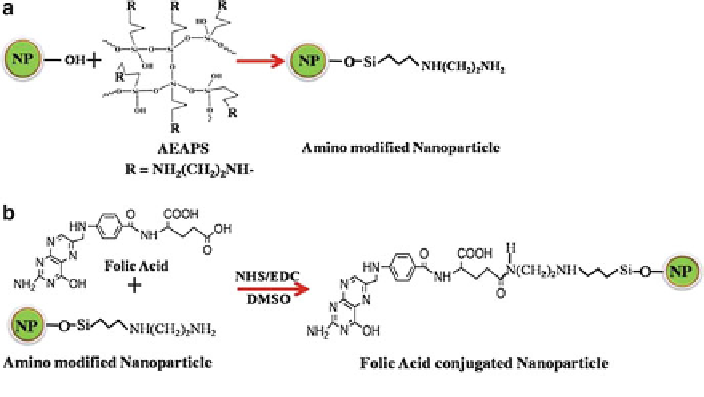Biomedical Engineering Reference
In-Depth Information
Fig. 20 Reaction mechanism for surface modification of luminomagnets with folic acid. (Adapted
from [
76
])
6.5 Magnetic Nanoparticles
Magnetic nanoparticles (MNPs) functionalized with the drug can serve as potential
drug carriers in a new drug delivery strategy based on the application of external
magnetic fields. The principle of drug delivery by nanomagnets is based on the use
of both constant and high-frequency oscillating magnetic fields. Since these
particles are magnetic in nature, they can be targeted to specific areas (e.g., cancer
tissues) by a constant external magnetic field. Their size, which is comparable to
biological functional units, and their unique magnetic properties allow their utili-
zation as molecular imaging probes. By tuning growth parameters, such as mono-
mer concentration, crystalline phase of the nuclei, choice of solvent and surfactants,
growth temperature and time, and surface energy, it is possible to control the size,
composition, and magneto-crystalline phase of MNPs. Non-hydrolytically
synthesized MNPs are typically coated with hydrophobic ligands. Therefore, it is
necessary to exchange these ligands for appropriate ones that will give high
colloidal stability in aqueous biofluids, and to avoid the aggregation that can
occur under harsh physiological conditions.
Over the past decade, a number of biomedical applications have begun to
emerge for magnetic micro- and nanoparticles of differing sizes, shapes, and
compositions [
78
]. Many applications still rely on the use of iron oxide particles
(usually Fe
2
O
3
or Fe
3
O
4
), like the original ferrofluids. These particles are available
with diameters ranging from ~300 nm to less than 10 nm. They exhibit superpar-
amagnetic behavior, magnetizing strongly under an applied field, but retaining no
permanent magnetism once the field is removed. This on/off magnetic switching

